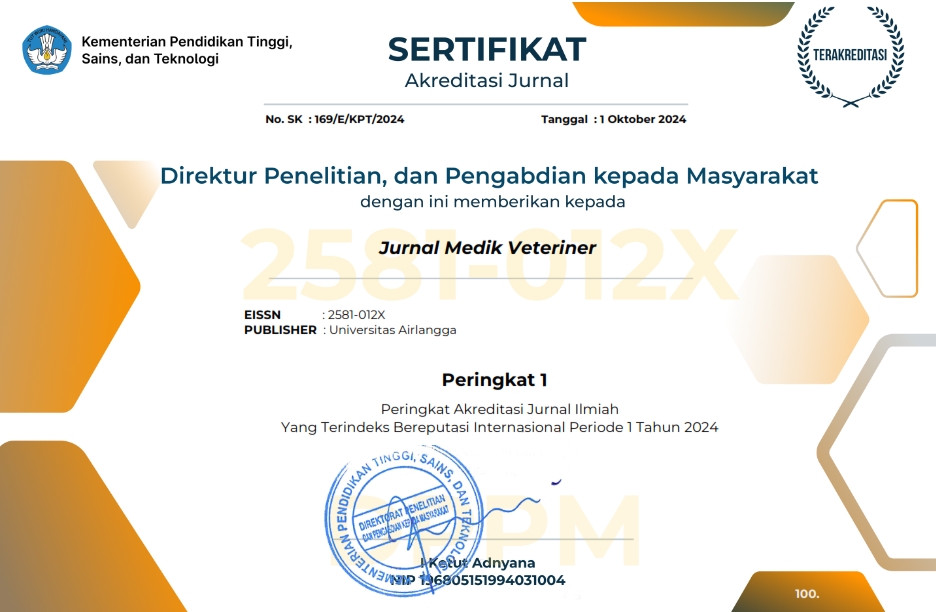Comparison of Antigenicity Between Local and Massachusetts Strains of Infectious Bronchitis Virus using Indirect ELISA Test

Downloads
The aim of this study was to compare the antigenicity between the whole virus and protein S of both local strain I-147 and Massachusetts strain of Infectious bronchitis virus with indirect ELISA. We used 10 positive serums from post vaccinated chickens for further reaction with four groups of antigens in this study that are: P1) S protein (spike glycoprotein) antigen of local strain IB virus; P2) S protein (spike glycoprotein) antigen of Massachusetts strain IB virus; P3) whole virus antigen of local strain IB virus; P4) whole virus antigen of Massachusetts strain IB virus. The results of this research are Optical Density (OD) values of each treatment, then to be analyzed using One Way ANOVA and followed by Duncan Multiple Range Test 5%. The results show that there are differences between the antigenicity of the whole virus and S protein in both local strain and Massachusetts strain of IB virus. The whole virus antigen of both strains has a significant difference (p<0.05) with the S protein antigen in both strains. Specifically, the whole virus antigen of Massachusetts strain has the highest OD among the other groups.
Bahri, S., Masbulan, E., & Kusumaningsih, A. (2005). Proses Praproduksi sebagai Faktor Penting dalam Menghasilkan Produk Ternak yang Aman untuk Manusia. Deptan RI. Hal: 4.
Cavanagh, D., Davis, P. J., Cook, J. K., Li, D., Kant, A., & Koch. (1992). Location of the amino acid differences in the S1 spike glycoprotein subunit of closely related serotypes of infectious bronchitis virus. Avian Diseases, 21, 33-43.
Cavanagh, D., & Gelb, J. (2008). "Infectious Bronchitis,” in Diseases of Poultry. Wiley-Blackwell, 12th edition. Pp: 117–135.
Cavanagh, D., & Naqi S. (2003). Infectious Bronchitis. In: Saif YM, Barnes HJ, Glisson JR, et al., eds. Diseases of Poultry. 11th ed. Ames, IA: Iowa State University Press. Pp: 101–119.
Cavanagh, D., & Naqi, S. (1997). Infectious bronchitis. In B.W. Calnek (Ed.). Diseases of Poultry, 10th ed. Iowa State University, Ames, IA. Pp: 511-526.
Cook, J. K. A., Jackwood, M., & Jones, R. C. (2012). The Long View: 40 Years of Infectious Research. Avian Pathology, 41, 239-50
Darminto. (1992). Serotyping of Infectious Bronchitis Viral Isolates. Penyakit Hewan, 24(44), 76-81.
Darminto. (1995). Diagnosis Epidemiologi and Control of Two Mayor Avian Viral Respiratory Disease in Indonesia: Infectious Bronchitis and Newcastle Diseases. Thesis (Ph.D). JCU Univ.
De Groot, R., (2012). Family Coronaviridae. In: King, A.M.Q., Adams, M.J., Carstens,E.B., Lefkowitz, E.J. (Eds.), Virus Taxonomy, the 9th Report of the International Committee on Taxonomy of Viruses. Elsevier Academic Press, San, Diego. Pp: 806–828.
Dharmayanti, N. L. P. I., Indriani, R., Darminto. (2005). Hubungan Kekerabatan Virus Infectious Bronchitis Isolat Lapang Indonesia. Jurnal Bioteknologi Pertanian, 10(1), 15-23.
Indriani, R., & Darminto. (2000a). Penyakit Infectious Bronchitis pada Ayam dan Cara Mengendalikannya. Wartazoa, 5(2), 65-72.
Indriani, R., & Darminto. (2000b). Variasi Serotipe Isolat-Isolat Virus Infectiuos Bronchitis yang Berasal dari Beberapa Daerah di Pulau Jawa. Jurnal Ilmu Ternak Veteriner, 5(4), 234-240.
Indriani, R., & Dharmayanti, N. L. P. (2013). Development of an Enzyme-linked Immunosorbent Assay for Detection of Infectious Bronchitis Antibody in Chicken Using Local Isolate Virus. JBI, 9(2).
Rahmawati, A., Wijaya, N. S., Purnama, M. T. E., Rahmahani, J., Yudhana, A., & Yunita, M. N. (2018). Pengaruh Ekstrak Kulit dan Jus Buah Delima Putih (Punica granatum L.) Terhadap Titer Antibodi Ayam Kampung Super yang Divaksin Newcastle Disease. Jurnal Medik Veteriner, 1(3), 68-73.
Rantam, F. A. (2003). Metode Imunologi. Airlangga University Press. Surabaya. Hal: 79-81.
Tabbu, C. R. (2000). Penyakit Ayam dan Penangulangannya.Penyakit Bakterial, Mikal dan Viral. Volume 1. Penerbit Kanisus, Yogayakarta. Hal: 32.
Tizard, I. R. (2009). Veterinary Immunology: An Introduction (Eight Edition). Department of Veterinary Pathobiology. Texas. Viruses: a WHO Memorandum. Pp: 52.
Copyright (c) 2022 Jola Rahmahani, Daniswara Irwanza Akbar, Suwarno

This work is licensed under a Creative Commons Attribution-NonCommercial-ShareAlike 4.0 International License.
Authors who publish in this journal agree to the following terms:
1. The journal allows the author to hold the copyright of the article without restrictions;
2. The journal allows the author(s) to retain publishing rights without restrictions;
3. The legal formal aspect of journal publication accessibility refers to Creative Commons Attribution-NonCommercial-ShareAlike 4.0 International License (CC BY-NC-SA).






11.jpg)




















